Porcelain Insulator News
by Elton Gish
Reprinted from "Crown Jewels of the Wire", November 1997, page 9
This month we have a variety of things to discuss most of which have never
been reported before. As many of our loyal PIN readers know, "new"
porcelain insulators are being reported all the time. I appreciate receiving
photographs and details of any porcelain insulators you have questions about;
however, we often do not have the space to publish all of the reports.
Jeff Hogan reported getting a very rare M-2250 at the London, OH show in
November 1996 with a #7-1 Fred Locke marking on the upper surface of the top
skirt. He also saw two unmarked M-2250's there, too (The London Show is a great
national-quality show each year. I hope to see you there this year.). Only one
other marked M-2250 is known! Jeff pointed out that the marking did not match
that shown in Jack Tod's 3rd edition book, Porcelain Insulator Guide Book. Upon
closer inspection of Jeff's marking and others in my collection, I discovered
that the first word in the marking was recorded wrong in Jack's book. While
checking the accuracy of the list of Fred Locke markings for Jack's new book, I
often had to check the same marking on several insulators to put together as
complete a marking detail as possible. Only one of my insulators with the #7-1
marking shows the first word clearly. I later remembered that I corrected the
#7-1 marking when I published my book, Fred M. Locke: A Biography, in 1994.
Note that the first word in the #7-1 marking is not composed of all capital
letters (PAT'D), but rather only the first letter is capitalized (Pat'd). For
the record, the correct #7-1 marking is shown below:
Pat'd Nov. 24, Dec. 15, 1893,
Sept. 26, 1897, June 7, 1898,
May 29, 1900,
April 30, 1901,
June 17, 1902, F. M. Locke |
7-1 Error 1893 instead of 1896,
Sept. 26 instead of Sept. 28. |
By the way, the only other marked M-2250 actually has two #7-1 markings
neither of which have a readable "Pat'd"! While on the subject of
M-2250, Bob Stahr (NIA #4186) acquired two large pieces of M-2250 shown in the
next photograph from Robert Schultz who found them along a railroad right-of-way
in northern Illinois. Both pieces have the #7-1 marking on the upper surface of
the top skirt.
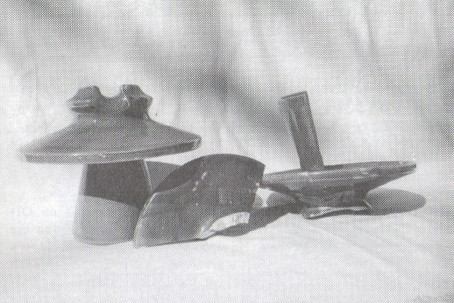
M-2250 (left) with two #7-1 markings and two pieces
of M-2250 found along
original power line.
Note the piece in the center has the #7-1 marking
as does
the larger piece on the right.
After the Rosemont National show this past July, about 100 collectors met at
the home of John & Carol McDougald (NIA #689 & #1076) in St. Charles, IL
where we were all treated to a wonderful box lunch dinner. We had a great time
visiting with each other and viewing the various McDougald collections. I
especially liked the wonderful way they displayed dozens of blue and white
lightning rod balls suspended from the ceiling around the kitchen cabinets.
Sure, it was fascinating to see the basement with its hundreds of insulators,
more lightning rod balls, and the lighted display case on the first floor with
all of the super colorful and rare glass insulators. However, my attention was
immediately drawn outside where multipart porcelain insulators lined the deck.
There was a large variety of multipart and other porcelain insulators but three in particular caught my attention.
The first one looks
like a cobalt blue "witch's hat". The bottom disk (with two petticoats
like a suspension insulator) is 12 inches in diameter and the insulator is 10
inches tall. You can see in the photograph that the cone is covered with sand
(actually small bits of porcelain) fused to the glazed surface. The inside
surface of the cone is sanded the same way. The sanded surfaces make for a
better adhesion of the Portland cement that held several "witch's
hats" together. I could not find this insulator shown in any catalogs;
however, I am sure that several of these were cemented together. The final
assembly (with metal bracket on top and bottom) was probably used to support a
bus bar in a substation. Someone recently reported that a retired lineman-friend
described just such an insulator he got from a substation composed of
cone-shaped sections.
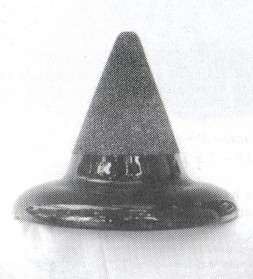
Cobalt blue porcelain "witch's hat". Note sanded
cone for
cementing another like insulator on top.
The next insulator is a 2-part multipart with 15-inch diameter top skirt
and a very unusual crown. Note it does not have a tie-wire groove -- only a 3/4"
cable groove formed in the 5-inch diameter crown. The color is speckled rust with a large VICTOR R=oo logo indicating it was made in
the early
191 0' s. There were many theories discussed about how this insulator could
have been used. I believe that it was an early form of bus bar support for use
in a substation. Perhaps the bus bar was secured on each end clamped to another
insulator and this insulator was simply used to support the weight of the
bus-bar in the cable groove without need of a tie-wire or cable clamp. It is
difficult to imagine other uses where the conductor would not require a tie-wire
or clamping device secured to the insulator.
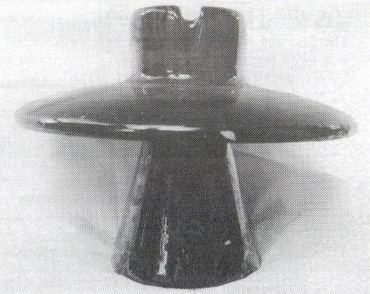
M-2999 with Victor R=oo logo marking.
15 - 7 x 12
The third insulator is one we have seen a few times over the years. It was
reported twice in CJ (12-71-29 and again in 9-76-32). In the 1970's, they were
often seen at shows. Some of these insulators are marked with an anchor and
"U. S. NAVY" and all have had a dark. brown glaze. The rectangular
base is 6" x 8" and curved as if to fit on a 3-1/2" diameter
pipe. The insulator is 23 inches tall with many upwardly curving cable grooves.
Jack Tod's response in 1976 PIN was that these were probably used on submarines
to hold arrays of low voltage cables in battery rooms. One of the Tibbitt's books (Vol. 3, page 99) states they come in various glaze colors andthere is a smaller version about half the size. All I have seen are this
large size. Collectors have nicknamed it the "Christmas Tree" and I
remember one display using this insulator with the title "Insulbug".
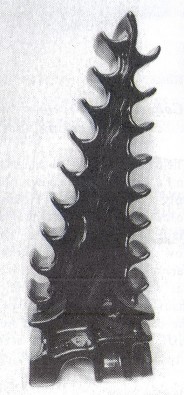
Odd insulator used on submarines
to carry cables in the battery room.
Gary Nilson, a long-time bottle collector from Wallingford, CT, sent the
following photograph of an interesting two-part porcelain insulator. It is made
of dry process porcelain as evidenced by the embossed (raised) marking:
"E"
PATENT PENDING
The glaze color is rust with some mustard mixed in. This is the same glaze R.
Thomas & Sons used on dry process pin-types in the early 1910's. I have
seen a few of these insulators over the years but none had such an attractive
glaze. I do not remember if any of them had markings.
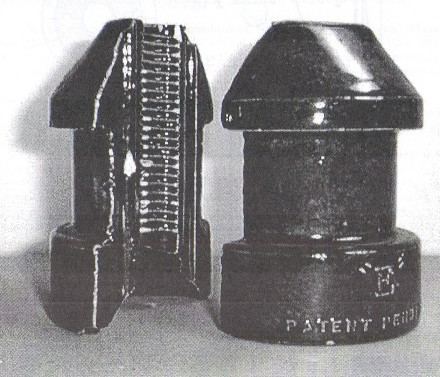
Louis Fort insulator for street light conductors
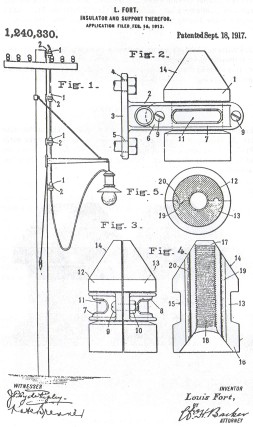
Medium Image (95 Kb)
Large Image (216 Kb)
'This insulator was made based on the Louis Fort patent No. 1,240,330 granted on September 18,
1917. The
patent pending marking indicates that it was made just before the patent was
granted and after the patent application date of February 16, 1912. This
confirms my estimate of the age based on the glaze color. From the patent
drawing, we can see that both halves of the insulator were held together with a
metal bracket. The insulator assembly was attached to a pole in such a way as to
secure a vertical conductor dropped down from the crossarm and run to a street
light. Note the serrations or ribs on the inner surface of the insulator. The
patent claimed, "these serrations become embedded in said insulating
material [covering the conductor] and prevent moisture which would tend to run
down the insulator working between the conductor and the interior surface of the
insulator." The large "E" marking may indicate a specific
insulator size. There could have been different sizes in overall dimension as
well as gauge (diameter) of conductor the insulator was designed to secure.
| 